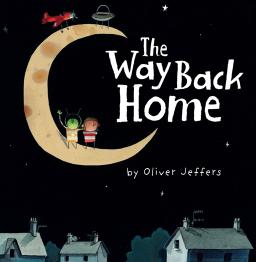
The Way Back Home
فرمت کتاب
ebook
تاریخ انتشار
2008
Lexile Score
590
Reading Level
0-2
ATOS
3.1
Interest Level
K-3(LG)
نویسنده
Oliver Jeffersشابک
9780698148802
کتاب های مرتبط
- اطلاعات
- نقد و بررسی
- دیدگاه کاربران
نقد و بررسی

April 7, 2008
Jeffers's (The Incredible Book Eating Boy
) arrestingly illustrated book begins with the creation of a spare watercolor world—a single, nameless boy on a deserted beach. Quickly the story takes a surprising turn: the boy finds an airplane in his closet and crashes it on the moon. When he's joined by a similarly stranded Martian, the two strangers hatch a scrappy plan for rescue, suggesting a moral: it's good to work together. After the unusual narrative leaps at the beginning of the story, the message feels a little forced, and it's less fun than expected. Even so, a quality reminiscent of The
Little Prince
comes through, not just in the lone boy/outer-space setting, but in the balance between the humor in the predicament and loneliness. These two emotions are matched perfectly by the mixed-media art. Colorful figures swim in vast amounts of negative space, isolated and a bit melancholy, but their postures and faces are playful, almost comic. An odd scale and lopsided figures suggest a world off-kilter, while silly monsters and impossible feats keep things light. With uneven graphite outlines on watercolor-soaked paper that reveals the grain of the paper, the overall effect is tactile, textured and even a little childlike. Ages 4-up.

April 1, 2008
PreS-Gr 2-Surprised but unfazed to find an airplane in his closet, a boy flies it to the moon, runs out of gas, meets a similarly stranded Martian, and makes a new friend. The charm of this story is how completely it maintains a childlike perspective. The boy is putting a full-size rowboat away when he finds the airplane: "He didn't remember leaving it in there, but he thought he'd take it out for a go right away." This approach continues in the watercolor, graphite, and collage artwork. Figures consist of circle heads, box bodies, and stick legs; the backgrounds are flat colors with a few scribbled-in clouds or puffs of exhaust. Humorous details abound. Before his initial flight, the boy systematically dresses in jacket, scarf, helmet, goggles, and gloves, then does a few stretches to prepare fully. After meeting the Martian, he parachutes home for supplies but gets distracted by his favorite television show. The Martian waits, impatiently checking his wristwatch. Eventually, the boy returns to the moon via a rope, both vehicles are repaired, and the travelers prepare to depart, wondering if they will ever meet again. The last page provides hope of keeping in touch when the boy receives an unusual transmitter in the mail. The message that friends are friends whether they are near or far comes through in a warm, amusing manner."Lucinda Snyder Whitehurst, St. Christopher's School, Richmond, VA"
Copyright 2008 School Library Journal, LLC Used with permission.

April 15, 2008
In this childlike fantasy, a boy finds an airplane and takes it out for a rideto the moon, where it runs out of fuel. Just as his flashlight grows dim, a spaceship crashes, and a Martian climbs out. Initially, each fears the other, but they quickly become fast friends. Soon theyre carrying out a splendid plan to repair their spacecraft and get back to their homes. Children who know Jeffers Lost and Found (2006) and How to Catch a Star (2004) may recognize the distinctive figure of the boy, with his large head, sticklike legs, and striped shirt, and catch other visual references to the earlier books. Economy of line in both text and pictures combine with Jeffers flair for storytelling to create plenty of fine, original scenes. The deadpan text is well matched by the slightly quirky pencil-and-watercolor illustrations, which make great use of color and composition on the large, double-page spreads. An imaginative space adventure for young children.(Reprinted with permission of Booklist, copyright 2008, American Library Association.)

























دیدگاه کاربران